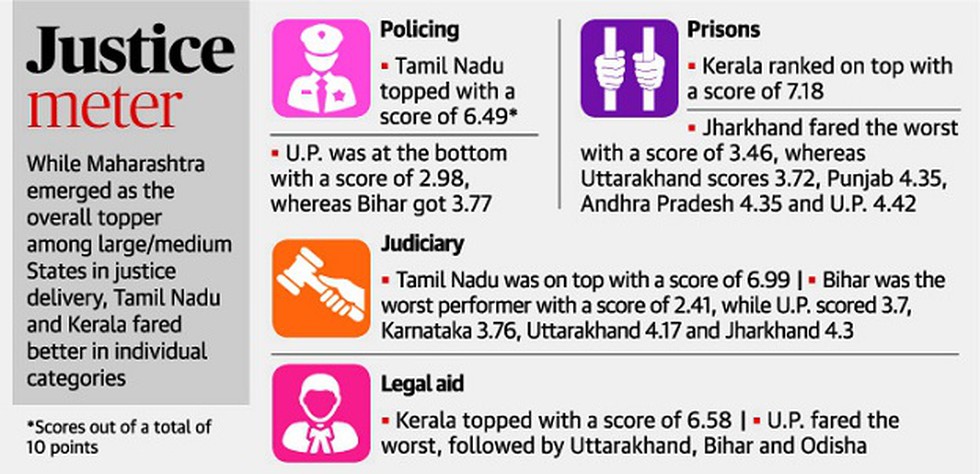Governance
India Justice Report, 2019
- 08 Nov 2019
- 5 min read
Why in News
Recently, the India Justice Report (2019) prepared by the Tata Trusts in collaboration with the Centre for Social Justice, Common Cause, and the Commonwealth Human Rights Initiative has been released.
- This is the first-ever ranking of Indian states on justice delivery.
- The report has divided states on the basis of the population into two parts:
- The large-medium states (Population 1 crore and above)
- The small states and Union Territories (Population less than 1 crore)
Key Points
- Maharashtra has topped the list among large-medium States followed by Kerala, Tamil Nadu, Punjab, and Haryana.
- In this category, Jharkhand, Bihar and Uttar Pradesh are at the bottom.
- Goa leads the list of smaller states followed by Sikkim and Himachal Pradesh.
- The report has been prepared based on publicly available data of different government entities on the four pillars of justice delivery — police, judiciary, prisons, and legal aid.
- Each pillar is analyzed through the prism of budgets, human resources, personnel workload, diversity, infrastructure, and five-year trends.
Issues with Indian Justice System
- Vacancies
- On average, the police have a vacancy of 23% (2017), and the judiciary between 20%-40% across the high courts and lower judiciary. Gujarat is the only state to reduce vacancies across all four pillars.
- Representation
- No State/ UT is able to meet all its diversity quotas (ST, SC, and OBC). Karnataka comes closest to achieve diversity quotas (missed its SC reservation target by 4%).
- Women are poorly represented across the Justice system. They account for 7% of the Police, 10 % of Prison staff and about 26.5 % of all judges in the High Court and subordinate courts.
- Budgets
- The Justice system is affected by low budget allocations.
- The per capita expenditure on legal aid is just 75 paise.
- Punjab is the only large state whose police, prison and judiciary expenditures have increased at a pace higher than the increase in overall state expenditure.
- Judicial Pendency
- Nationally, at the subordinate court level, on average a case remains pending for five years or more.
- Only six states i.e. Gujarat, Daman and Diu, Dadra and Nagar Haveli, Tripura, Odisha, Lakshadweep, Tamil Nadu, and Manipur managed to clear as many court cases as were filed.
- Prisons
- Prisons are over-occupied at 114%, where 68% are undertrials awaiting investigation, inquiry or trial.
Way Forward
- Judiciary and the government needs to put collaborative effort to plug the gaps in the management of the police, prisons, forensics and the filling up of vacancies.
- The efficient Indian Justice System will ensure the implementation of Article 14 (Equality before law), Article 22(1)(Protection against arrest and detention in certain cases) , Article 39(A) (Free legal aid for poor) and Article 21 (Right to protection of life and personal liberty) of the Indian Constitution.
- It will also ensure SDG 16 which recognizes the need to ‘provide access to justice for all and to build effective, accountable and inclusive institutions at all levels.
Constitutional Provision
- Article 39A of the Constitution of India provides that State shall secure that the operation of the legal system promotes justice on a basis of equal opportunity, and shall, in particular, provide free legal aid, by suitable legislation or schemes or in any other way, to ensure that opportunities for securing justice are not denied to any citizen by reason of economic or other disability.
- Articles 14 and Article 22(1) also make it obligatory for the State to ensure equality before the law and a legal system that promotes justice on a basis of equal opportunity to all.






-min.jpg)